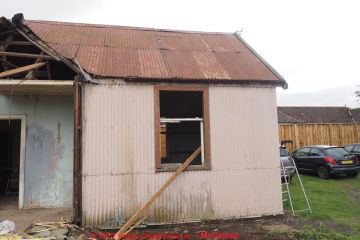 Requirement to Ground Metal Building Siding?
Requirement to Ground Metal Building Siding?
Generally not required by code, with possible exceptions
- POST a QUESTION or COMMENT about this article topic
This article explains that it is not normally required to bond metal building siding to the building's electrical ground system.
Page top photo: metal siding on an older electrical building, along with a local grounding electrode and grounding conductor.
InspectAPedia tolerates no conflicts of interest. We have no relationship with advertisers, products, or services discussed at this website.
- Daniel Friedman, Publisher/Editor/Author - See WHO ARE WE?
Metal Building Siding Bonding & Grounding
Our photo shows an older steel sided building in Hudson, New York.
[Click to enlarge any image]
Bottom line: in general metal building siding is not required to be connected to the building's electrical ground system.
However there may be exceptions, given in more detail below. Some state, provincial, or local building codes, such as the Ohio electrical code may require that metal building siding or metal buildings should be grounded.
Does aluminum siding or other metal building siding need to be bonded to the electrical ground system?
Reader Question: I inspected a home built in the 1970's, Suffern NY Is it required for metal clad siding to be bonded?
Would you call it out. - Dovber Kahn by private email, 20245/03/25
Note: Mr. Kahn is a professional home inspector serving Rockland and Bergen Counties in New York.
Moderator reply: electrical codes do not require that metal siding be grounded or bonded to the electrical system.
I have not found a general requirement that buildings metal siding such as aluminum or steel siding has to be electrically grounded.
Metal siding is not within the scope of the U.S. National Electrical Code - it is not "electrical equipment". See FPN to NEC 250.116 given below.
But here are examples of apparent exceptions.Ohio Building Code Chapter 14, Exterior Walls
1405.11.4 Grounding
Grounding of metal veneers on buildings shall comply with the requirements of Chapter 27 of this code. - source: 2011 Ohio Building Code refers to Chapter 27 - Electrical
Really? note that the words "ground" or "siding" do not appear in that chapter.Ohio: 1466.02 INSTALLATION OF ALUMINUM AND STEEL SIDING.
No aluminum or steel siding shall be installed on any building or dwelling unless such siding is grounded on all four corners of the building or dwelling.
(Ord. 89-70. Passed 10-16-89.)
§ 1472.01 GROUNDING.
Where aluminum and other metal siding is used on the exterior of a building or other structure, the siding must be securely grounded in the following manner.
(a) Apply one inch wide bare conductors of the same alloy and the same gauge or greater, then the veneer panels. Bond all conductors together.
(b) Fasten the ground wire to a lower conductor, then securely fasten to the common grounding system of the structure.
If none is available, the ground wire shall be fastened to an approved ground rod of not less than five-eighths inch diameter and eight feet long extending eight inches above ground and may need to be through the siding. Underwriters’ Laboratories, Inc. approved fittings are required. Use number 8 aluminum ground wire or larger.
Where ground rods are used, there shall be a ground rod on the opposite sides of the building. As panels are applied to the wall, fasten overlapping conductors with a one and one-fourth inch aluminum or bimetal sheet metal screw at all points.(c) Use a sufficient number of conductors in all vertical and horizontal panel areas to provide adequate bonding. Grounding must be inspected before siding is applied. (Ord. 73-O-41, passed 8-7-1973)
- source: American Legal Publishing, retrieve 2024/03/25, original source: https://codelibrary.amlegal.com/codes/columbiana/latest/columbiana_oh/0-0-0-14781
and for structural metal that might include a metal outbuilding at a residential property if it has electrical power:
US NEC 250.104 Bonding of Piping Systems and Exposed Structural Metal
(C) Structural Metal
Exposed structural metal that is interconnected to form a metal building frame, is not intentionally grounded or bonded, and is likely to become energized shall be bonded to any of the following:
(1) Service equipment enclosure
(2) Grounded conductor at the service
(3) Disconnecting means for buildings or structures supplied by a feeder or branch circuit
(4) Grounding electrode conductor, if not smaller than a conductor sized in accordance with Table 250.102(C)(1)
(5) One or more grounding electrodes used, if the grounding electrode conductor or bonding jumper to the grounding electrode is not smaller than a conductor sized in accordance with Table 250.102(C)(1)
The bonding conductor(s) or jumper(s) shall be sized in accordance with Table 250.102(C)(1), except that it shall not be required to be larger than 3/0 AWG copper or 250 kcmil aluminum or copper-clad aluminum, and installed in accordance with 250.64(A), (B), and (E).
The points of attachment of the bonding jumper(s) shall be accessible unless installed in compliance with 250.68(A), Exception No. 2. - retrieved 2024/05/25, original source: https://up.codes/viewer/texas/nfpa-70-2023/chapter/2/wiring-and-protection#250.104
OPINON (DF) - Multi-Panel Metal Siding Can Not Be Reliably Grounded
In fact since there are so many loosely connected parts in any metal building siding installation, no individual parts grounded or bonded to the grounding electrode conductor would be reliable for the whole building.
I think there is some confusion between grounding metal buildings or metal structures and grounding metal siding or providing lightning strike protection for buildings, including metal roofed or metal sided buildings.
Model codes and other authorities also state that siding must be installed following the manufacturer's instructions. So if you came across a manufacturer's requirement for grounding that would pertain - I've not come across such references.
Connection of Building Siding to Local Grounding System May be Unsafe
Anecdotal report: I (DF) investigated a building at which an occupant, working outside, was badly shocked when he touched the aluminum-sided home. We found that the siding had been connected to a local grounding conductor, perhaps at an outdoor wall receptacle.
When the building experienced a short to ground at the electric clothes dryer circuit, a combination of defects in the grounding conductor (not well connected to a local ground rod) in turn, energized the building siding.
Lightning Strike Or Other Unusual Electrical Contacts Impact Metal Siding
Separately about metal siding and electrical power shorts or lighting strike impacts, you might be interested to learn that at a building fire that I investigated with Jess Aronstein many years ago we were amazed to find the quarter trim of metal aluminum siding have fallen off of the building everywhere.
Apparently a tree grew up to touch high voltage power lines that caused a sort down to ground through the tree, traveling through its roots to both the home and a detached garage. At the house the current surged up a metal handrail and into the building siding.
Current flowed through the siding at a sufficient level to melt the aluminum rivets that were holding those parts in place. The real disaster was a building fire that began with the same power surge set the electrical panel on fire. Simultaneously the surge melted the water supply pipe so that the basement flooded while the upper building burned.
The same power surge sent so much current under a detached garage slab that it caused a sub-slab moisture explosion that in turn sent the car hurtling up through the roof of the garage to land outside.
Thank you for an interesting question about electrical grounding for metal siding.
References on Requirement to Ground Metal Building Siding
- National Electrical Code - Ch. 1426
- NEC 250.104(C) Structural Metal Parts grounding is required for "parts that are likely to be energized" such as electrical panels or equipment.
- NEC 250.116 Use copper clad steel rod 3/4" diameter and 10'-0" long spaced at 100'-0" maximum - use #1/0 copper wire."
- US NEC 250.116 FPN - ground for additional safety where extensive metal in or on buildings may become energized.
“Where extensive metal in or on buildings may become energized and is subject to personal contact adequate bonding and grounding will provide additional safety”.
Fine print notes are informational only and are not enforceable as requirements of the Code (90.5(C). - Ohio Basic Building Code - Ch. 1420
...
Continue reading at GROUND SYSTEM INSPECTION - home, or select a topic from the closely-related articles below, or see the complete ARTICLE INDEX.
Or see these
Recommended Articles
- LIGHTNING PROTECTION SYSTEMS
- ALUMINUM SIDING
- ELECTRICAL GROUND ERROR-CAUSED LEAKS - leaks in metal water pipes traced to improper grounding
- STEEL & IRON BUILDING SIDING
- LOST ELECTRICAL GROUND
- LOST NEUTRAL SHOCKS HOMEOWNER
Suggested citation for this web page
METAL SIDING ELECTRICAL GROUND? at InspectApedia.com - online encyclopedia of building & environmental inspection, testing, diagnosis, repair, & problem prevention advice.
Or see this
INDEX to RELATED ARTICLES: ARTICLE INDEX to ELECTRICAL INSPECTION & TESTING
Or use the SEARCH BOX found below to Ask a Question or Search InspectApedia
Or see this
INDEX to RELATED ARTICLES: ARTICLE INDEX to BUILDING SIDING
Or use the SEARCH BOX found below to Ask a Question or Search InspectApedia
Ask a Question or Search InspectApedia
Try the search box just below, or if you prefer, post a question or comment in the Comments box below and we will respond promptly.
Search the InspectApedia website
Note: appearance of your Comment below may be delayed: if your comment contains an image, photograph, web link, or text that looks to the software as if it might be a web link, your posting will appear after it has been approved by a moderator. Apologies for the delay.
Only one image can be added per comment but you can post as many comments, and therefore images, as you like.
You will not receive a notification when a response to your question has been posted.
Please bookmark this page to make it easy for you to check back for our response.
IF above you see "Comment Form is loading comments..." then COMMENT BOX - countable.ca / bawkbox.com IS NOT WORKING.
In any case you are welcome to send an email directly to us at InspectApedia.com at editor@inspectApedia.com
We'll reply to you directly. Please help us help you by noting, in your email, the URL of the InspectApedia page where you wanted to comment.
Citations & References
In addition to any citations in the article above, a full list is available on request.
- In addition to citations & references found in this article, see the research citations given at the end of the related articles found at our suggested
CONTINUE READING or RECOMMENDED ARTICLES.
- Carson, Dunlop & Associates Ltd., 120 Carlton Street Suite 407, Toronto ON M5A 4K2. Tel: (416) 964-9415 1-800-268-7070 Email: info@carsondunlop.com. Alan Carson is a past president of ASHI, the American Society of Home Inspectors.
Thanks to Alan Carson and Bob Dunlop, for permission for InspectAPedia to use text excerpts from The HOME REFERENCE BOOK - the Encyclopedia of Homes and to use illustrations from The ILLUSTRATED HOME .
Carson Dunlop Associates provides extensive home inspection education and report writing material. In gratitude we provide links to tsome Carson Dunlop Associates products and services.



